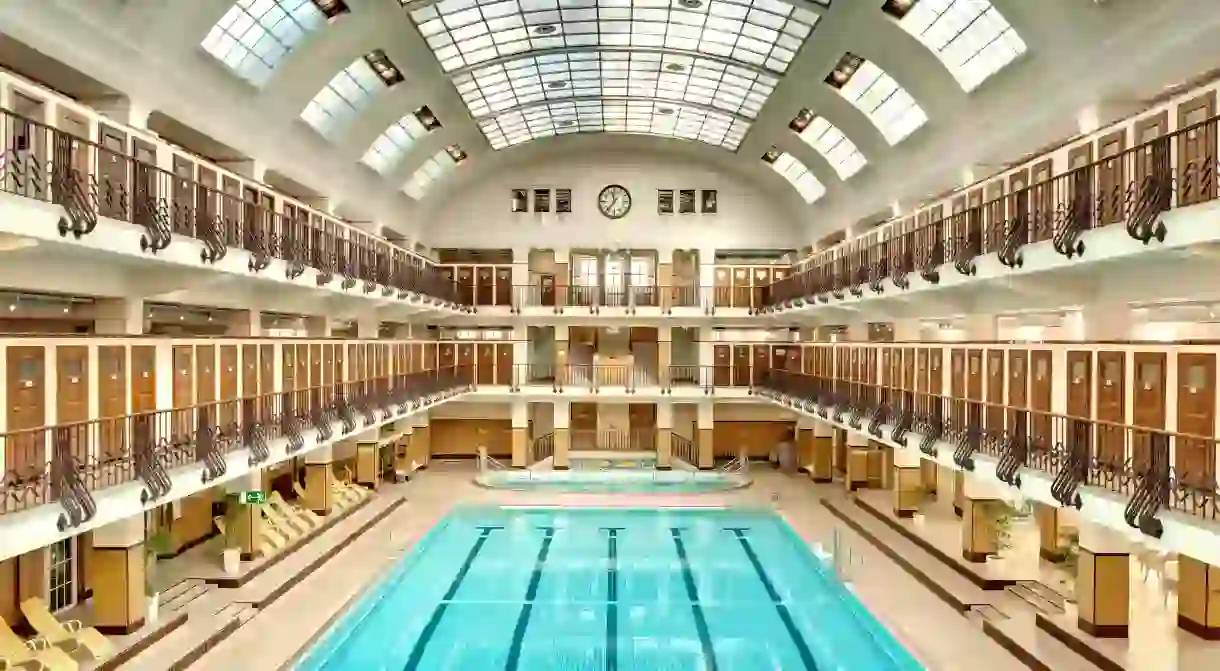Bodies of Water: The 10 Most Beautiful Public Pools From Around the World

From Europe to South America, we’ve rounded up the best public pools across the globe to get your togs on and go for a splash in.
Icebergs Club
Swimming Pool

Sluiced and caressed by the roiling surf, Bondi Baths is a 50m-long (164ft) ocean pool, part of the Bondi Icebergs Club, established in 1929 as a winter swimming club for hardy local lifeguards. Now, however, anyone can swim here. A very Australian combination of sportif seriousness – the pool is huge and packed with dogged lane-swimmers – and the awesome forces of nature, as the sea hammers with dramatic and often perilous intensity around its edges. The original club house was just a simple tin shack, now long gone and replaced by a terraced building commanding spectacular ocean vistas.
Der Spiegel Publishing House
Swimming Pool
Famed for his exuberantly psychedelic palette, curvaceous forms and penchant for experimentation, Danish architect and designer Verner Panton created this insanely kaleidoscopic pool for employees in the basement of the Der Spiegel’s Hamburg publishing house in 1969. The rest of the office is a similarly glorious exercise in retina-searing hues. The last gasp of the ’60s is orgasmically expressed in a kind of aqua disco, with nothing left to the imagination. Possibly the only thing missing is a glitter ball. Sadly, the pool was destroyed in a fire, but Panton’s other riotous interiors still endure, now lovingly preserved as national treasures.
Tinside Lido
Swimming Pool

The English coastline is dotted with Art Deco lidos, delectable globs of ice-cream architecture dedicated to the peripatetic pleasures of summer. Opened in 1935, Plymouth’s Tinside Lido is a scorcher, embedded on a promontory overlooking the Plymouth Sound and featuring a colossal, semi-circular pool. Enjoyed by successive generations of holidaymakers, its streamlined vanilla contours perfectly chime with its role as a place of carefree, seaside delight. Yet, like many British lidos, it has experienced neglect and darker times, even closing in 1992. After a period in the wilderness, when its future was uncertain, it was saved and refurbished, triumphantly reopening in 2005.
Leça Da Palmeira Pools
Swimming Pool

Cradled within a landscape of rock pools, this swimming complex on the Atlantic coast near Porto elegantly integrates nature and artifice. Designed by renowned Portuguese architect Álvaro Siza, it was one of his earliest projects dating from the mid 1960s, and shows a characteristically deft touch, framing and defining two existing tidal pools, while also adding changing rooms, showers and walkways. The relationship between the concrete elements that mark routes down to the pools and the stark geology of the rock-encrusted terrain is beautifully considered, set against a backdrop of rolling Atlantic surf and infinite sea views.
SESC 24 de Maio
Building, Library, Swimming Pool, Theater
Széchenyi Baths
Spa, Swimming Pool, Health Spa

Budapest is blessed with an abundance of natural hot springs, and its famous Széchenyi Baths, a yellow Neo-Baroque wedding-cake fantasy dating from 1913, has the distinction of being Europe’s largest thermal baths. Replenished from an artesian well 1,000m (328ft) underground, a bewildering labyrinth of 15 indoor and 3 outdoor pools is perpetually rammed with pleasure seekers, swimming, chilling, cavorting and playing aqua chess. A healthful array of saunas, steam rooms and therapeutic treatments is also available. The baths are open on both Christmas Day and New Year’s Day, the perfect remedy for stubborn festive hangovers.
Stadtbad Neukölln
Swimming Pool
Amalienbad
Swimming Pool

Piscine Suzanne Berlioux
Swimming Pool
Named after a famous coach of the French women’s swimming team, this 50m-long (164ft) pool is in a cavernous concrete grotto in Les Halles, the subterranean shopping centre and transport interchange in the heart of Paris. For comparison, imagine the improbable scenario of an Olympic-scale pool buried deep underneath London’s Oxford Circus. Designed by French architect Paul Chemetov in 1985, who had a thing about megastructures, the concrete pool cave is surprisingly light and airy, illuminated by daylight reflected into its depths by a cunningly designed winter garden. This is a hidden Parisian gem well worth seeking out.
Werksschwimmbad
Swimming Pool

Bodged together from a couple of disused shipping containers, this free, public summer pool in the ruins of the Zollverein colliery near Essen was conceived in 2001 by artists Dirk Paschke and Daniel Milohnic. It forms part of the ambitious repurposing of the former mining complex, the largest in the world and designated a UNESCO World Heritage Site, as a vast park for leisure and recreation. Framed against a backdrop of decaying coke ovens, the Werksschwimmbad is decidedly bijoux at only 12m (39ft) long, but what it lacks in size, it more than makes up for in its extraordinary setting, a glorious symphony of post-industrial ruin porn.













